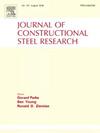Critical temperature prediction in cold-formed steel columns exposed to local fire
IF 4
2区 工程技术
Q1 CONSTRUCTION & BUILDING TECHNOLOGY
引用次数: 0
Abstract
The structural performance of cold-formed steel (CFS) compression members can be significantly affected when exposed to non-uniform thermal distributions, particularly under localized fire. A nonlinear finite element model has been developed and is found to be in good agreement with previous experimental studies. Based on the developed model, extensive parametric investigation encompassing a total of 1728 FE simulations is carried out for heat transfer analysis (320), and column strength computation (128) and thermo-mechanical simulations (1280) considering a broad range of geometric, thermal, and load combinations. The findings indicate that the lowest critical temperature (θcr) predominantly occur in the mid-height heating zone due to a combination of localized heating and buckling instability. The study also reveals that the initial applied load level (LL) is the most influential factor on failure temperature, with a strong inverse correlation (ρθ,LL = −0.76). At 70 % LL, the θcr varies between 335 °C (for L = 1600 mm) and 432 °C (for L = 2800 mm), whereas at 30 % LL, it ranges between 171 °C and 219 °C. Eight supervised machine learning (ML) regression algorithms are evaluated for their critical temperature (θcr) predictive capabilities using various statistical metrics. Among these the support vector regression (SVR) is found to outperforms other ML algorithms, providing consistent prediction accuracy. Additionally, the Shapley additive explanation (SHAP) approach is used to understand the ML models, offering insights into how various factors influence the θcr. This study shows the potential of machine learning techniques in predicting θcr for structural fire design and the behaviour of CFS components in localized fire environments.

求助全文
约1分钟内获得全文
求助全文
来源期刊

Journal of Constructional Steel Research
工程技术-工程:土木
CiteScore
7.90
自引率
19.50%
发文量
550
审稿时长
46 days
期刊介绍:
The Journal of Constructional Steel Research provides an international forum for the presentation and discussion of the latest developments in structural steel research and their applications. It is aimed not only at researchers but also at those likely to be most affected by research results, i.e. designers and fabricators. Original papers of a high standard dealing with all aspects of steel research including theoretical and experimental research on elements, assemblages, connection and material properties are considered for publication.
 求助内容:
求助内容: 应助结果提醒方式:
应助结果提醒方式:


